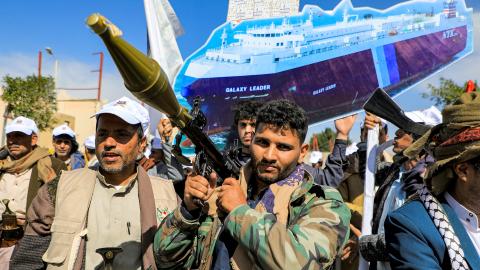The Middle East and North Africa (MENA) Defense Intelligence Digest is a monthly political-military and geopolitical assessment series from Hudson Institute. Below, Hudson Senior Fellow Can Kasapoğlu offers an overview of the contemporary Middle Eastern strategic agenda.
1. A High-Ranking US Admiral Confirms the Presence of the Iranian Revolutionary Guard Corps in Yemen
The deputy commander of United States Central Command (CENTCOM), Vice Admiral Brad Cooper, confirmed that members of the Iranian Revolutionary Guard Corps (IRGC) now have boots on the ground in Yemen, where they are operating alongside the Houthi militia and providing them with targeting assistance. Admiral Cooper’s statement is the most high-profile acknowledgement from the US military of Iran’s direct role in the Houthis’ disruptive campaign against global maritime trade and the US Navy.
Recent reports confirm Admiral Cooper’s assertion and note that high-ranking IRGC General Abdolreza Shahlaei was sent to Yemen some time ago to personally oversee operations. General Shahlaei is a target of the US State Department’s Rewards for Justice program, which is offering $15 million for any information revealing his exact location.
The presence of the Iranian spy vessel Behshad in the Red Sea, where it has been providing intelligence, surveillance, target acquisition, and reconnaissance (ISTAR) capabilities to the Houthis, further illuminates the scope of Iran’s efforts in Yemen. Marine traffic tracking data suggests that the Behshad has recently moved closer to the Chinese military base in Djibouti to seek protection from US strikes.
According to several news outlets, last week US forces allegedly attempted to conduct a cyberattack to cripple the Behshad and limit its ability to share intelligence with the Houthis. That the Biden administration resorted to a cyberattack rather than any of the military options at its disposal speaks to the staying power of its Obama-era Iran policy, which aims to avoid confrontation but only cedes the reins of escalation dominance to Tehran.
2. Limited Preventive Strikes Are Proving Tactically—But Not Strategically—Important
The Houthis’ disruptive campaign against maritime trade in the Red Sea prompted the United States and United Kingdom to launch Operation Poseidon Archer, a series of preventive and punitive strikes against various tactical Houthi assets.
Operation Prosperity Guardian, another joint effort from the American and British navies, is also launching preventive strikes in Yemen. One such strike on January 16 destroyed several Houthi missiles still in their launch positions. American and British forces have focused some of their preventive actions on degrading the militia’s disruptive military capabilities, including its surface-to-air missile (SAM) systems and unmanned surface vehicles and drones.
But while US and British efforts have targeted the Houthis’ tactical assets, the strategic value and scale of the West’s preventive strikes have thus far remained limited. Operations Prosperity Guardian and Poseidon Archer have fallen short of neutralizing the Iran-backed group’s critical capabilities and have barely attempted to dismantle the IRGC presence in Yemen. More importantly, the campaigns have failed to deter Iran or the Houthi leadership from launching continued broadsides.
The Houthis have continued to threaten the US forward presence in the Middle East. Recently, a Houthi missile came dangerously close to hitting a US Arleigh Burke–class guided missile destroyer, the USS Gravely, just days after another attempted strike on a different US destroyer, the USS Carney. These incidents marked the most significant recent escalations at sea that the US Navy has witnessed in the region. The USS Gravely thwarted the attack by employing its Phalanx Close-In Weapon System (CIWS), saving the vessel from potentially severe damage to its platform and crew.
3. The Houthis Reportedly Downed Another US Unmanned Aerial System
In early November 2023, the Houthis allegedly downed a US MQ-9 Reaper drone over the Red Sea. This past week, the group intercepted another American drone of the same kind, marking the second MQ-9 downed since the outset of the conflict. The strike indicates that the Iranian proxy group’s target set includes critical, high-tech assets with a heavy price tag.
Open-source intelligence has not yet identified any additional Iran-supplied air defenses in the Houthis’ hands. But Iran’s lethal 358 loitering SAM—also known in Yemen as the Saqr (Hawk)—is a prime suspect in the Reaper attacks.
A menacing weapon with a distinctive design philosophy, the 358 missile is best described as a loitering air defense asset. It is launched from the ground and employs a solid-fuel rocket booster that burns out and falls to earth following the initial ascent. Then the missile transitions into a new flight pattern utilizing a turbojet that mimics a cruise missile. The weapon, equipped with air inlets along its rear that are molded to its engine segment, lurks while flying in figure-eight patterns and dives onto a target after detecting it.
The 358 provides the Houthis with another lethal capability that can threaten high-value US platforms operating over the Red Sea.
4. Iran-Supplied Underwater Drones Join the Houthis’ Arsenal
On February 18, US CENTCOM announced that the Houthis’ arsenal now includes underwater naval drones supplied by Iran. According to the announcement, the drones, similar to the Iranian kamikaze underwater variants in the class, are a new addition to the Houthis’ disruptive military capabilities in missile and drone warfare.
This new threat should be taken seriously. Underwater drones are more difficult to detect and intercept than surface vessels. Moreover, available evidence suggests that Tehran has established a growing underwater drone arsenal, featuring assets ranging from one-way-attack drones to the extra-large Nazir-1 unmanned underwater vehicle. The Houthis’ new weapons could pose a significant threat to US Navy assets in the region.
5. A Maritime Coalition Headed by the European Union Joins the Fray
February 19, 2024, marked the entry of a new defensive coalition into the Red Sea theatre: the European Union’s Naval Force (EUNAVFOR) Operation Aspides—“shield” in ancient Greek—has joined the fight to counter the rapidly growing Houthi threat. According to the European External Action Service (EEAS), the coalition seeks to provide a fast and robust reaction to Houthi attacks and help restore freedom of navigation in the Red Sea.
From a tactical standpoint, the addition of a new campaign in the region is no doubt significant. However, the significance of Operation Aspides will depend on its rules of engagement. It remains to be seen if the EU effort will engage in preventive strikes, as the UK and US have done, or only fire if fired upon.














